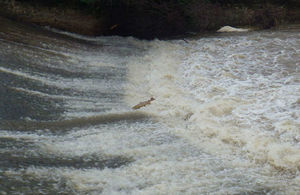Signs of a salmon resurgence on Somerset river
Environment Agency officers report plenty of salmon activity in Taunton.

A salmon spotted leaping up the River Tone in Taunton in November 2016
Heavy rain invariably brings fears of flooding, but there’s one creature that looks forward to a spell of wet and wintry weather – the Atlantic salmon.
Good numbers of these impressive fish have been seen on the River Tone this autumn as they migrate upstream to their spawning grounds. Sightings have included salmon leaping weirs and ascending fish passes in Taunton and on the upper reaches of the river.
Adult salmon, some weighing more than 10lb, arrive in the River Parrett from the sea before entering the Tone at the confluence of the two rivers near Burrowbridge. The fish wait in the lower reaches of the river until water levels rise sufficiently to allow them to swim upstream to spawn.
The recent heavy rain is just what the salmon have been waiting for and has triggered their migration upstream.
Environment Agency officers out checking flood defences on the River Tone have seen plenty of activity, including salmon ascending the fish pass at French Weir, Taunton and leaping near other river structures.
Fish surveys in 2015 revealed an encouraging increase in the number of young salmon in the tributaries of the Tone. Salmon parr (juvenile fish) have been found as high up the catchment as Waterrow where they had previously not been seen for over 20 years.
In the past couple of years the Environment Agency has repaired fish passes at French and Firepool weirs and this has also made it easier for salmon to swim higher up the catchment.
But there are still obstacles on the Tone and more work is needed to help salmon on their incredible journey upstream.
Matthew Pang of the Environment Agency said:
Salmon need clean and healthy rivers to survive. Sightings of good numbers of adult fish is excellent news and shows the work the Agency and its partners have done in recent years to improve water quality and remove physical barriers is paying off.
In the future, any new developments such as the Bridgwater Barrier or hydropower schemes will need to be assessed carefully by the Environment Agency to ensure they do not prevent or interrupt the migration of this iconic species and that measures, such as fish passes, are put in place if required.
The salmon is not the only creature to benefit from environmental improvements on the River Tone. In areas such as the Hillfarrance Brook there have also been sightings of otter, lamprey and bullhead. The presence of these key species is a sign of a healthy watercourse rich in biodiversity.
Notes to editor
- Lowland rivers such as the Tone are vulnerable to pollution and run-off from surrounding farmland and this can adversely affect salmon stocks. The Environment Agency has been looking at surrounding land management and working with the Farming and Wildlife Advisory Group (FWAG) to improve water quality and reduce the amount of sediment entering the river.
- One of the biggest threats to salmon spawning beds is silt. It clogs the riverbed with fine particles of soil and starves developing salmon eggs of oxygen.